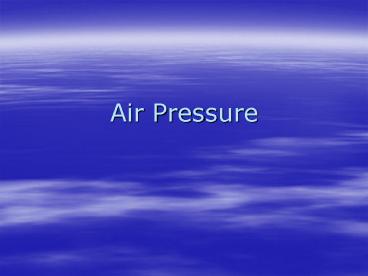Air Pressure - PowerPoint PPT Presentation
1 / 13
Title: Air Pressure
1
Air Pressure
2
Properties of Air
- Air contains atoms and molecules that have mass,
so air has mass as well. Since air has mass, it
also has other properties like density and
pressure. - Density
- Density is the amount of mass in a given volume
(dm/v). - the greater mass, the greater the density.
3
Pressure
- Pressure is the force exerted in a given area.
- Air pressure is the result of the weight of a
column of air pushing down on an area. The
molecules in air push in all directions and that
is why air pressure does not crush objects. - Denser air exerts more pressure than less dense
air.
4
Measuring Air Pressure
- A barometer is an instrument used to measure air
pressure. The most common are mercury barometer
and aneroid barometers. - Mercury barometer
- Consists of a glass tube open at the bottom end
and partially filled with mercury. The open end
rests in a dish of mercury and the space in the
tube above the mercury is a vacuum. - The air pressure that pushes down on the mercury
in the dish is equal to the weight of the column
of mercury in the tube. At sea level, the column
is on average 76 cm high.
5
View of a Mercury Barometer
6
Aneroid Barometer
- An aneroid barometer has an airtight metal
chamber that is sensitive to changes in air
pressure. - The thin walls of the chamber flex in and out as
the air pressure changes, which causes the needle
on the dial to move.
7
- Define the terms weather and atmosphere.
- 2. Why is the abundance of a gas in the
atmosphere usually shown as a percentage of dry
air? - 3. In decreasing order, what are the four most
abundant gases found in dry air on earths
atmosphere? - 4. What are two different processes that rely on
oxygen? In which two forms (please include
chemical formulas) is oxygen found in Earths
atmosphere?
8
(No Transcript)
9
Units of Air Pressure
- In weather reports, air pressure is usually given
in inches of mercury. National Weather Service
maps use millibars. - One inch of mercury equals 33.87 millibars. (25
846.75)
10
Altitude and Air Pressure
- Altitude, or elevation, is the distance above sea
level. As altitude increases, air pressure
decreases. As air pressure decreases, so does
density. - Air at sea level has the weight of the whole
atmosphere pushing down on it so air pressure at
sea level is the highest. - At the top of a mountain the air pressure is less
and so is airs density. This is why it is
difficult to breathe, since there is less oxygen
in each cubic meter of air.
11
5. How would the amount of carbon dioxide in
earths atmosphere change if there were no
plants? 6. How does water vapor in Earths
atmosphere relate to weather? 7. Describe
three ways in which Earths atmosphere makes the
Earth habitable for living organisms. 8. Why
does air exert pressure? What causes there to be
air pressure in Earths atmosphere?
12
9. What two instruments are typically used to
measure air pressure? 10. What two different
units of measure are commonly used to measure air
pressure? 11. One inch of mercury is equal
to how many millibars? Therefore, 29.5 inches of
mercury would equal how many millibars?
13
12. How are air pressure and air density
affected as altitude increases? Why does this
happen? 13. Is air pressure greater
at sea level (0 feet of elevation), or on the top
of Mount Everest (29,029 feet)?
Why? 14. Why do commercial airlines,
which typically fly at a cruising altitude of
35,000 feet, need to keep the cabins pressurized?































